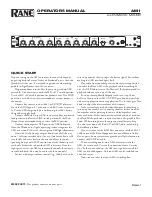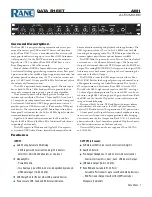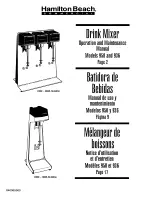
Anti-pop circuitry
The
Listen Four
Quarters
has a special feature that prevents the main outputs from popping or thumping when
the power is turned on. This avoids a common problem that happens when the power is accidentally turned off
and back on again while connected to a PA or powered speaker system, or the power is turned on after the
speakers are turned on. When using most mixers, the result is a loud pop that can damage the speakers (and
frighten anyone nearby!). The
Listen Four
Quarters
automatically mutes the outputs during power-on, thus
avoiding any pops.
Electrical and Mechanical Specifications
• 12HP Eurorack format module
• 1.13” (28.7mm) maximum depth (includes power cable)
• 10-pin Eurorack power header
•
Power consumption
•
Maximum values without using headphones jack:
Main outputs shorted to ground, headphones jack not used, maximum signal levels on all channels
•
+12V: 107mA
•
-12V: 101mA
•
Maximum values in worst-case conditions:
All outputs including headphone jack shorted to ground, maximum signal levels on all channels
•
+12V: 290mA
•
-12V: 101mA
• Main outputs
•
Output type: balanced zero-impedance, compensated for electrolytic capacitor distortion
•
Frequency Response: +/-0.2dB max deviation, 10Hz - 20kHz
•
Maximum output level: 17.1V peak-to-peak (+17.8dBu)
•
Maximum gain of channels 1 and 2: -4.4dB (hard-panned), -9.1dB (center-panned)
•
Maximum gain of channels 3 and 4, and INS header: -7.5dB
•
Channel bleed-through (Main Level attenuation):
Test conditions: Test signal input into each channel with Level knob at 100%. Frequencies from
20Hz to 20kHz tested. Result given as a ratio of the signal measured on main output jacks with
Main Level knob at 0%, to the signal measured with Main Level knob at 100%. Worst-case results
for any channel and frequency reported.
•
Output jack tip: <-110dB
•
Channel bleed-through (channel attenuation):
Test conditions: Test signal input into each channel with Level knob at 0% and Main Level knob at
100%. Frequencies from 20Hz to 20kHz tested. Result given as a ratio of the signal measured on
main output jacks with channel Level knob at 0%, to the signal measured with channel Level knob
at 100%. Worst-case results for any channel and frequency reported.
•
Output jack tip: -106dB
•
Channel cross-talk:
Test conditions: Test signal input into each channel. Level knob at 0%, and other channel Level
knobs at 100%. Main Level knob at 100%. Frequencies from 20Hz to 20kHz tested. Measured
signal subtracted from signal with all Level knobs at 0%, and result given in dB as a ratio to output
signal with test channels’ Level knob at 100%. Worst-case results for any channel and frequency
reported.
•
Output jack tip: <-110dB
•
Headphones jack
•
Frequency response: -0.2dB at 20Hz; 0dB at 100Hz to 20kHz (driving 32
Ω
headphones)
•
Maximum voltage (peak-to-peak): 5Vpp
Page of
7
7

























